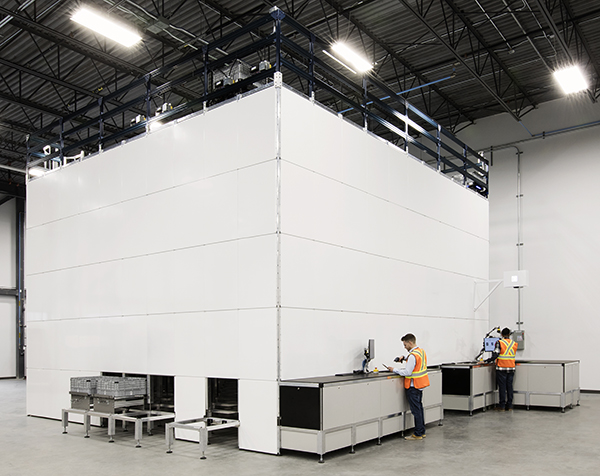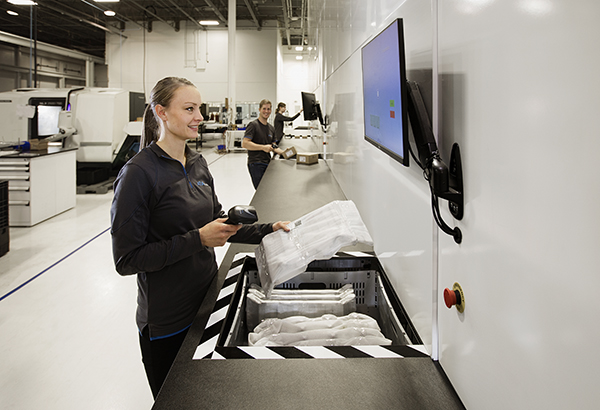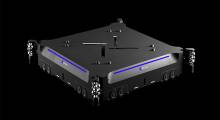Supply chain operations have been using robots to meet shifting demand, and the addition of artificial intelligence could help them even more. Attabotics today announced a partnership with AltaML Inc. and the Alberta Machine Intelligence Institute to add AI and machine learning to its supply chain infrastructure. The three organizations said they will work on projects combining AI with the Internet of Things to make operations more efficient, improve human-machine interactions, and enhance Attabotics' data management capabilities.
Calgary, Alberta-based Attabotics said it provides “the world’s first 3D robotics supply chain system for modern commerce.” Inspired by ant colonies, the company said its automated storage and retrieval system (ASRS) replaces the rows and aisles of traditional fulfillment centers with a patented structure and robotics shuttles that use both horizontal and vertical space, reducing a company’s warehouse space needs by 85%.
By enabling retailers to place fulfillment centers close to urban areas, Attabotics said it helps create jobs and decrease carbon emissions by closing the last-mile delivery gap. The company raised $50 million last August, and its North American customers include department store Nordstrom and other retailers across apparel, food and beverage, and home goods.
Edmonton, Alberta-based AltaML said it applies its AI expertise with partners' domain knowledge to develop systems that deliver data for predictive value and enhanced productivity. The Alberta Machine Intelligence Institute (Amii) is one of Canada’s three centers of AI excellence conducting machine learning (ML) research. The non-profit institute also provides educational offerings and business advice with the goal of building in-house AI capabilities.
Attabotics responds to e-commerce shifts
The COVID-19 pandemic has proven that the traditional supply chain is not sufficiently responsive to consumer behavior, according to Attabotics. Busineses need to integrate AI for transparency, predictive analytics, and network optimization, it said.
“Materials handling was pretty old-school, with lots of conveyance and telemetry reporting used very reactively,” said Mark Dickinson, vice president of software solutions at Attabotics. “In the past five to 10 years, we've started to see a lot of ASRS from Europe and companies like us disrupting the market for automated operations.”
“There has been a marked shift from the brick-and-mortar retail replenishment model to e-commerce environments,” he told Robotics 24/7. “On the fulfillment side, it used to be huge batch factors—you put stuff on a pallet, and off it went. Now, we're sending 15 operators to the same location to generate the same revenue as 18 months ago, while COVID has accelerated growth by about 10 years.”
“The Fortune 100 have started to transition away from a regular distribution center, which might have 100 stores assigned to it,” Dickinson said. “Now, they have distribution centers and e-commerce fulfillment centers. Most retailers are looking at leveraging all fulfillment points, including distribution partners and stores. Instead of 10 fulfillment points, you might have 1,500 to 5,000 like a Walmart.”

AI for predictive maintenance, tuning fulfillment
“We're trying to get this data, enhance it, and feed elements from outside the system, such as sensors, for feedback tools,” said Dickinson. “We're taking it to the point of predicting equipment failure and then pulling an element out of service to perform maintenance while minimizing downtime.”
The company uses Internet of Things (IoT) data derived from cloud-based robotic operations. It has worked with Microsoft for supply chain management on the Azure cloud platofrm, and it recently partnered with FoodX for grocery fulfillment.
“If you start to look at certain parameters, AI can suggest where to tune things,” Dickinson said. “For example, if the total open order pool is 60% of stated throughput, there's no reason to run it at 100%, or you could reduce the speed to delay maintenance windows.”
“How can we get more throughput out of fixed assets—anything that can touch items, such as lift trucks, conveyors, or operators?” he asked. “Most equipment providers have similar shuttles, mini-loaders, and pallet cranes. Robots move at fixed speeds, so you want to get to the most efficient picking process possible.”
“It's really how you're leveraging the software,” said Dickinson. “We've decoupled storage and the throughput engine, which allows us to be very dynamic in how we move orders through the system. We have the ASRS slotted for the highest cubic velocity. For example, there could be four iPhones with different cases—instead of four picks, we can make it one pick and add the cases. Our system is looking at fulfillment holistically.”
Partners to provide actionable data in real time
Attabotics added that AltaML and Amii will help it build out its digitally integrated, distributed network.
“AltaML builds and deploys AI-powered software for complex problems, creating new competitive advantage for our partners,” said Nicole Janssen, co-CEO of AltaML. “Attabotics has disrupted traditional warehousing, and we are thrilled to work with them and Amii to optimize their processes through applied AI.”
“Our intent is to display customer-level data in real time and provide trend analysis: 'Here's how to get where you want to be,'” said Dickinson. “We want to present information so it can affect operations today rather than tomorrow.”
“There are different ways a customer could use this system. They could want to see all SKUs [stock-keeping units] in our system, or a subset for a larger building,” he explained. “With AI and digital twins, you could run varying simulations to come up with suggested outputs.”

Trio demonstrates Canadian AI prowess
“We’re excited to work with two world-renowned organizations to build the future of innovation in Canada,” stated Scott Gravelle, CEO of Attabotics. “Creating alliances with industry-leading partners is something we’ve put an emphasis on, which is why we’re so grateful to have identified the right partners in AltaML and Amii to help further to optimize our platform as we revolutionize the supply chain.”
The partnership will also support the growth of Calgary and Alberta as an innovation hub, said the organizations.
“Amii is thrilled to be part of this one-of-a-kind collaboration bringing together three of Alberta’s leading technology organizations,” said Cam Linke, CEO of Amii. “Together, we’re demonstrating the province’s reputation as a hub for technology and artificial intelligence through the combination of Attabotics’ transformational work in advanced robotics for supply chain, Amii’s leadership and expertise in artificial intelligence research and development, and AltaML’s proven record in applying AI to create business impact.”
“This partnership shows the power of public-private partnerships and is further proof of Alberta’s leadership in the research and application of AI,” Linke said.
About the Author
Follow Robotics 24/7 on Linkedin
Article topics
Email Sign Up
















